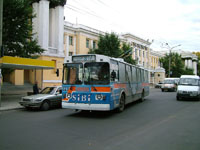 | 3-01. Lenina Ul. near Profsoyuznaya Ul.
ZIU-682G 223. Line 3 TRZ-bound.
Trolleybus leaves the stop in-front of the House of the Officers of the Russian Army at the beginning of the line via the eastern section of Lenina Ul.
(18 Sep 2004, YM) |
 | 3-02. Lenina Ul. / 9-go Yanvarya Ul.
ZIU-682V 175. Line 3 TRZ-bound.
The Stalin-era ensembles such as the one in the background of this photo are typical for the eastern part of the main Lenina Ul.
(18 Sep 2004, YM) |
 | 3-03a. Lenina Ul. / Barguzinskaya Ul.
ZIU-682G 238. Line 1 Gor.Bolnitsa-bound.
238 approaches the point of split between the lines to Gor. Bolnitsa and Sosnoviy Bor. This trolleybus will continue straight toward Gor. Bolnitsa.
(28 Sep 2004, YM) |
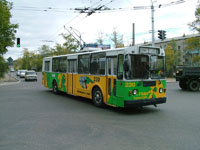 | 3-03b. Lenina Ul. / Barguzinskaya Ul.
ZIU-682G 230. Line 1 Depot-bound.
The city-bound trolleybus approaches the same intersection from the other direction. 230 was delivered next after the unique "southerner" 229, yet it is another standard Russian ZIU-682G.
(28 Sep 2004, YM) |
 | 3-04a. The Gor.Bolnitsa Terminal (the City Hospital).
ZIU-682V 172 on the left. Line 1.
ZIU-682G 232 on the right. Line 1.
Upon the split between the two eastern lines, the Gor. Bolnitsa extension continues via Lenina Ul. only as far as one stop. Here trolleybuses during a short layover at the terminal. Despite relatively small distances covered, all terminals are equipped with dispatching facilities.
(28 Sep 2004, YM) |
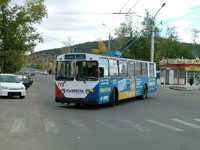 | 3-04b. The Gor.Bolnitsa Terminal (the City Hospital).
ZIU-682V 172. Line 1.
The Gor. Bolnitsa Terminal of Line 1 is literally located at the edge of the city. Trolleybus 172 just completed a loop at the terminal and is about to head back toward Chita-II Station and Depot.
(28 Sep 2004, YM) |
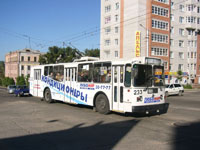 | 3-05. Barguzinskaya Ul. / Chkalova Ul.
ZIU-682G 233. Line 3 Sosnoviy Bor-bound.
Switching back and continuing via the Sosnoviy Bor extension, served by Lines 3 and 6.
(15 Jul 2005, Alexandr Polsha) |
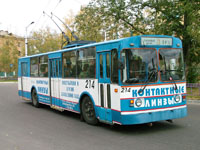 | 3-06. Barguzinskaya Ul. / Babushkina Ul.
ZIU-682G 214. Line 3 TRZ-bound.
Trolleybus loops around a sizeable square at the above mentioned intersection.
(28 Sep 2004, YM) |
 | 3-07. Belorusskaya Ul. / Alexandro-Zavodskaya Ul.
ZIU-682G 203 on the left. Line 3 TRZ-bound.
ZIU-682G 223 on the right. Line 3 Sosnoviy Bor-bound.
One stop short of the Sosnoviy Bor Terminal.
(18 Sep 2004, YM) |
 | 3-08. Alexandro-Zavodskaya Ul. near Silikatnaya Ul.
ZIU-682G 200. Training vehicle.
Upon approaching the Sosnoviy Bor Terminal.
(15 Jul 2005, Alexandr Polsha) |
 | 3-09a. The Sosnoviy Bor Terminal.
From left to right: ZIU-682G 239; ZIU-682G 214; ZIU-682V 184; VMZ-5298 250; ZIU-682V 183.
Trolleybuses are laying over at the terminal during a lunch break. It is 19:45 now, but these particular trolleybuses are scheduled to operate late into the night. Upon completing lunch they are to relief vehicles that remain in circulation now, allowing the latter to retire for the night.
(18 Sep 2004, YM) |
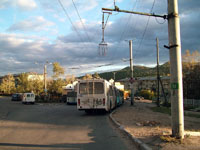 | 3-09b. The Sosnoviy Bor Terminal.
From left to right: ZIU-682V 163; VMZ-5298 245.
As many as ten trolleybuses are parked for lunch simultaneously. Each line in the city is operated on the 3-4 min. headway throughout the day, except for the day-time lunch between 10:00 and 12:00, when the headway is 6-8 min. After 19:00 the headway goes up to 6-8 min. again, during the evening lunch, and after that, when only half of the fleet remain in service. A sustainable late night operation is highly uncommon for modern Russia. Note the power leakage control mechanism attached to the pole in the front of this photo.
(18 Sep 2004, YM) |
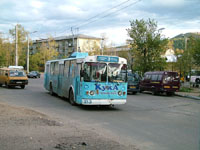 | 3-09c. The Sosnoviy Bor Terminal.
ZIU-682V 183. Line 2 TRZ-bound.
183 carries on while others are having lunch.
(18 Sep 2004, YM) |
 | 3-09d. The Sosnoviy Bor Terminal.
RAF minibus.
Old RAF minibuses built in the Soviet Republic of Latvia could still be found serving gypsy taxibus lines in 2004. Unlike in other Russian cities, at the time of this photo, gypsy minibus services in Chita had a negligible share in local transportation market. All minibuses were of cheap domestic Russian-built models, a highly unusual fact, considering relative proximity of East Asian manufacturers that supply most gypsy minibus services in the Russian Far East.
(18 Sep 2004, YM) |